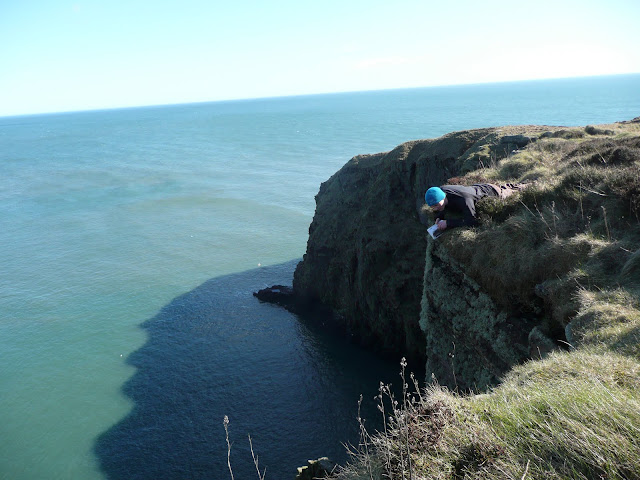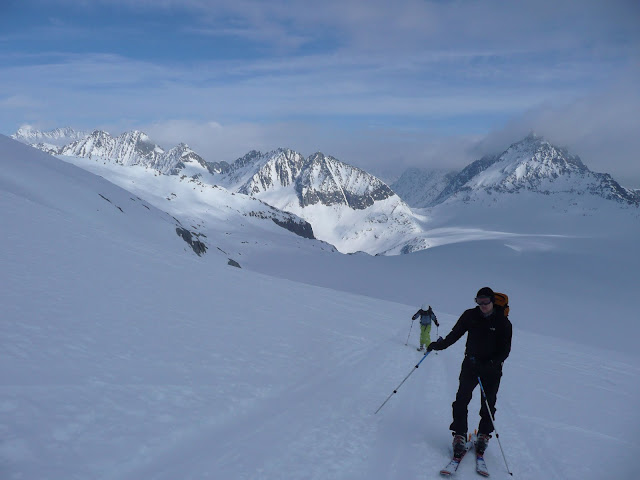While Steve has had the benefit of the European winter to assist with his preparation, the remainder of the team has been busy back in NZ trying to get the most out of an un-seasonally dry and warm summer. For me this has meant less time out on snow and ice than I would have liked, and instead has lead to a focus on longer alpine rock routes. This has turned out to be a blessing in disguise as rock climbing has never been a strong point of mine, and it has given me the opportunity to strengthen a weakness in my climbing.


Allan leading steep ice on the South face of Mt Barnicoat, on the 1st pitch, left, and 5th pitch, right.
After capping off a packed winter/spring season by snaring two memorable climbs on the South faces of Mt Barnicoat and Mt Tutoko. The first involving the second ascent of a stellar ice line, “Lust for Life”, via a new direct variant with Allan Uren and the second a 1200m new route climbed with Guy McKinnon on Tutoko’s daunting south face. I then turned my attention to the Remarkables range behind Queenstown and headed out for a series of multi-pitch climbs on the local schist.

The South Face of Mt Tutoko. Our route linked a series of snow and ice gullies up the left side of the face.
The first excursion of the summer saw me heading out in mid January with Danny Murphy and Anna Ruotsi to attempt a new route up the wide spur between the South and West faces of Single Cone - in conditions that were anything but summer like. After savouring the breathtaking view down to Lake Wakatipu as we scrambled around the Queens Drive we were struck by a numbing southerly wind that was whipping around the base of the face. Eager to warm up and escape from the cold we quickly racked up and I lead what off on what would be the first of seven pitches we climbed that day.

Ben leading out through a small overhang low down on SW spur of Single Cone.
The line we took followed the broad crest of the spur direct to a point just below and south of the main summit. It started out on steep, compact and well featured schist offering great climbing before easing back and becoming less secure as we neared the top of the spur. Ending with two run out, scrambling pitches leading to a final sting in the tail in the form of a small head wall below the summit ridge.


Danny leading a steep juggy corner on the 4th pitch, left, and belaying from the base of the 5th pitch, right.
The following weekend and again I was heading back up into the Remarkables - eager to get back out onto the rock. This time paired up with Andrew Finnigan we headed toward the South face of Single Cone, where we hoped to find more of the compact schist that we had encountered low on the SW spur the previous weekend. The result - a new seven pitch route up the centre of the face, starting to the right of the winter ice lines and topping out on the ridge leading to Single Cone with a crux of grade 18. While the quality of the rock was definitely an improvement from that on the SW spur the climb failed to take the direct line we envisaged, as we were forced to take a meandering line following weaknesses on the upper slabs. Still a good trip out into the hills nonetheless!


Andrew leading the crux overhanging crack on the 2nd pitch, above, and seconding up steep slabs on the upper face, below.


The promise of an extended fine mid-week forecast in early February saw me slogging it up the Tasman Glacier with Mike Rowe for our final trip out into the hills before we leave for Nepal. Our objective – the South face of Malte Brun.
A long day’s walk on the approach took us to a bivvy spot high in the Betham Valley from where we hoped to launch our attempt the following morning. And after an “Alpine sleep-in” we struck out towards the face hoping to attempt a new direct route up the centre of the face.


Mt Cook dominates the horizon as we scramble up from the Tasman Glacier, top, into the Betham Valley below Malte Brun, bottom.The climb itself consisted of 16 pitches, with another couple soloed at the base, on rock which could best be described as of variable quality. While we encountered plenty of the solid and compact 'pink' rock, which the peak is famous for, throughout the climb it was interspersed with sections of loose choss. But on the whole it was a truly enjoyable outing typically moderate ground with a few tougher bits thrown in the mix to make things interesting and was a great way to form a partnership.
 Trying to keep to the solid rock - Mike leading out on the second to last pitch below the summit ridge.
Trying to keep to the solid rock - Mike leading out on the second to last pitch below the summit ridge.Topping out on the summit ridge at 7:15pm we then descended via the classic West Ridge in failing light to a bivvy spot perched above the Malte Brun glacier and continued out down the Tasman the following day.


Mike descending over the iconic ‘Cheval’ on the upper West ridge, left, and waking to a picturesque dawn at our bivvy above the Malte Brun Glacier the following morning.
Now finally back in Queenstown all there is left to do is pack…………..the most daunting task to date!
 All kitted up and ready to go – Nepal here we come!
All kitted up and ready to go – Nepal here we come!
Well that wraps up my preparation and I am now eagerly awaiting my flight out tomorrow. Again I would like to express my thanks to all of our friends and supporters who have helped out along the way with putting the expedition together - without your assistance this amazing trip would not be possible.
Watch this space for updates on our progress as we head into the Khumbu!
Cheers - Ben











